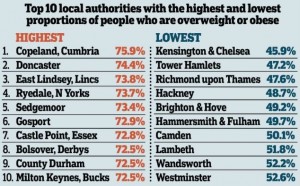New data reveals how the obesity crisis affects different areas of the country
Areas in the North are worst affected, according to official figures
London and the South West have the thinnest people in terms of BMI
With the glorious Lake District at its heart, you’d expect the locals in Cumbria to be a pretty fit bunch.
However, the county has just waddled away with the title of England’s fattest.
Sixty-eight per cent of its residents are either overweight or obese – so fat that it threatens their health.
Map below shows the top 10 fattest areas of the country – rated by the % of people with a BMI of more than the ‘healthy’ maximum of 25
Fat England: Alarming new figures show 64 per cent of people are overweight or obese – raising their risk of an early death. Map shows the top 10 fattest local authority areas of the country, according to BMI
Thin capital: The London local authorities pictured had the lowest levels of obesity in all of England, according to the figures
Not only that, but the Cumbrian district of Copeland has the fattest of the fat, with an astonishing 75.9 per cent pushing the bathroom scales past tipping point.
The figures are contained in data, issued for the first time, which reveals the fattest and thinnest parts of England and the scale of the obesity crisis.
Overall, 63.8 per cent of adults in England are overweight or obese.
THE FATTEST ENGLISH REGIONS
North East (68% are overweight or obese)
North West 66%
West Midlands 65.7%
East Midlands 65.6%
Yorkshire and the Humber 65.4%
East of England 65.1%
South East 63.1%
South West 62.7%
London 57.3%
Chasing Copeland for the title of the worst area are Doncaster, on 74.4 per cent, and East Lindsey in Lincolnshire, on 73.8 per cent.
After Cumbria, the fattest counties are North Yorkshire and Staffordshire, both on 67.9 per cent.
The fattest region is the North-East, where 68 per cent are overweight or obese, followed by the West Midlands at 65.7 per cent.
The slimmest English residents live in the wealthy London borough of Kensington and Chelsea, where only 45.9 per cent are overweight or obese.
The London boroughs of Tower Hamlets (47.2 per cent) and Richmond upon Thames (47.6 per cent) are close behind.
Obesity is measured using the body mass index (BMI) score which is calculated by dividing a person’s weight in kilograms by their height in metres squared.
Anything under 25 is fine. BMI of 25 to 29.9 is classified as overweight and clinical obesity is defined as 30 or greater.
Top 10 local authorities with the highest and lowest proportions of people who are overweight or obese
Obesity crisis: Copeland in Cumbria (pictured) is the fattest local authority area in England, alarming new figures have revealed
Tam Fry, of the National Obesity Forum, said: ‘The figure of 64 per cent for the country is bad enough but when figures rise to around 80 per cent for some local areas one has to believe that the problem may be insurmountable.
The projection that 50 per cent of the country could be obese before 2050 could unfortunately come to pass unless really radical steps are taken now by central government to tackle the problem.’
Joseph Clift, of the British Heart Foundation, said: ‘Put simply, too many people weigh too much. This should be a catalyst for action at a local and national level.’
Obesity costs the NHS £5.1billion a year, according to the National Audit Office. The total cost to the economy of being overweight or obese has been put at some £16billion in 2007, rising to £50billion a year by 2050 if left unchecked.
Back in Cumbria, Copeland Borough Council’s Gillian Troughton said: ‘We recognise that obesity is a national problem, and one which affects Copeland.
‘One big example of how we are tackling it is that we are investing in protecting our leisure facilities at a time of Government cuts, and continuing to offer those in receipt of benefits discounted access to the range of facilities we provide, which will soon include a new gym facility.’
Source: Daily Mail

